
Бесплатный фрагмент - Hidden Hunter-Gatherers of Indian Ocean
With appendix
FOREWORD
Whom we imagine when talk about hunter-gatherer? A dark-skin small man almost without any clothes, with a spear or bow and arrows. His family live in a deep rainforest or in an endless savannah, they make a fire by drilling, live a nomadic life and know nothing about agriculture and pastoralism. It is enough for a standard person who is ready to forget everything that doesn’t concern with his everyday job. But if you read this book — you are not such a person.
We also know that their lifestyle is the most ancient and 90% of all human beings who ever lived on our beautiful planet (~80 000 000 000 individuals) were hunter-gatherers (Lee & DeVore 1968). It is the most effective, most harmonized and ecological way of connection between humans as biological specie and all the nature itself. Living as a hunter and gatherer, human don’t opposite themselves to the nature by a constant fighting in a constant process of production food by keeping cattle (making pastures, killing predators, overgrazing) or agriculture (slash-and-burn cultivation, deforestation, invasion of plants). Every anthropologist who is interested in hunter-gatherers knows such iconic peoples as Hadza of Tanzania, Baka of South-East Cameroon and Mbuti of North-East DRC, Bushmen of South Africa and Kubu of Sumatra, about Andamanese and Indigenous Australians
But at the same time there are several peoples who are always very far from the mainstream anthropology. They seem to be classical agriculturalists who live normal sedentary life.
Sometimes it is almost impossible to be sure about some concrete ethnic group — are they real hunters and gatherers or just have some elements of occasional foraging (and such elements may be non-indigenous). People of Zanzibar archipelago go to forage wild fruits and berries, fallen coconuts and many kinds of seafood at a low-tide at a regular basis — the resources of islands and surrounding waters are limited and strongly depend on the weather season and ocean streams. But at the same time most of them involved in farming, fishing and trade — traditional occupations of this archipelago for many centuries. Still it is hard to classify such peoples as Veddahs of Sri Lanka and Mikea of Madagascar. Meanwhile such peoples as Birhor of Central India and Chepang of Central Nepal aren’t connected with living traditions of hunting and gathering. But exactly these peoples go to forage and even sometimes hunt small game more often than such “classical” hunter-gatherers as Veddahs. There are extremely few studies about the origins of the Mlabri and about their hunting and gathering traditions. Less can be found about Ahikuntikas people (it is good if you just heard about them).
By writing of this book I tried to use a powerful basement of previous studies since XIX century till modern days and build a little (but comfortable I suppose) house, entering which a wanderer can find some answers. In this book we will try to make a short overlook on some of such people who live around Indian Ocean — from Northern Thailand to South Madagascar, from Sri Lanka to Himalaya. We will point islands and coasts, mountains and savannahs. And everywhere we will meet them — hunter-gatherers who remain hidden. So, let our journey begins!
I want to thank those people who always help me on the path of my life — my beloved wife Elena Erkina, my darling mother Tatiana Khromova and my dearest father Marlen Gabbasov. Thank you for everything!
Sergey Marlenovich Gabbasov
SPIRITS OF THE YELLOW LEAVES
Mlabri are an important people, one of the few remaining cases of mongoloid hunters who hunt using spears, rather than bows and arrows or blowpipes. Documentary records made by local Buddhist priests inform that Mlabri offered honey, rattan, wax and other forest products to the kings as tribute every year (Bernatzik 1938).
Most studies about the Mlabri prior to the 1970’s described them as a nomadic group living in the jungle, with some contact with outsiders such as exchanging forest resources for tools and rice (Nimmanahaeminda and Hartland-Swan 1962; Young 1961; Bernatzik 1951; Wanadorn 1926; Seidenfaden 1919). Studies after the 70’s began to mention a transition in the patterns of exchange — not only for bartered goods, but also labor was exchange for goods, especially for food (Trier 1992; Pookajorn 1992).
The Siamese elite in Bangkok attitude to the Mlabri as “khon pa” and considered them completely different from the Thai (“khonthai”). The “khon pa” are defined as “early men” or “old humankind” (“khonderm”) who are still living in the jungle (Pookajorn 1985). Other ethnic groups, such as the Lawa, the Yang (Karen), the Khmu, as well as the Hmong or the Lahu, are sometimes also included in this classification (Na Nan 2007). For the Mlabri, the term “phi pa” (“forest spirits”) was sometimes used and referred to their lack of permanent settlements. All these peoples, especially the nomadic Mlabri, were of little interest to the Kingdom of Thailand until the 1970’s (Na Nan 2016).
Thai exonym to the Mlabri is “Phi Tong Luang” (lit. “spirits of the yellow leaves”). According to the Thai perspective, this nomadic group would move to another places whenever the banana leaves (“tong”) covering the roofs of their shelters turned yellow (“luang”) and it was said that they could move as quickly as if they were spirits (“phi”) (Kerr 1924).
Their endonym — Mlabri — consists of two words: “Mla” means “people” and “bri” is “forest”. The term “Yumbri” with the same meaning was in use in the past times (Nimmanahaeminda 1963). Diffloth put Mlabri and Yumbri in two different branches of the Mon-Khmer subdivision: Mlabri to Paluangic and Yumbri to Khmuic (Diffloth 1973). Bernatzik also separated Mlabri and Yumbri (Bernatzik & Bernatzik 1958), but Rischel assumed that they were varieties of the same language (Rischel 1995).
The Mlabri were also called “Phi Pa” (“forest spitits”) or “Khon Pa” (“forest people”) in Thai and “Mang Koo” in Hmong. The Laotian know them as “Kha Tuang Luang”. They usually call themselves “mlaq” (“human beigns”) and “mlaq briq”, but they are better known to the general Thai people as “phi tong lueang” (“spirits of the yellow leaves”): “spirits” is an allusion to their hiding in the forest to avoid to contact with outsiders, and “yellow leaves” refer to the fact that they abandon their windscreens when the palm or banana leaves they are made of turned yellow (Surin 1992; Bernatzik 1951). Later, the attitude of the State changed, and the Mlabri, as many other upland ethnic groups, were classified as “chao kao” or “hill tribes” (Rischel 1995).
The Mlabri speak an Austro-Asiatic language belonging to the Khmuic branch of the Mon-Khmer language family. Some scholars (Chazée 2001; Boeles 1963; Flatz 1963; Nimmanahaeminda 1963) refer to the Mlabri as Mrabri. However, Danish linguist Jørgen Rischel, who researched the Mlabri language in Thailand and Laos in the late 1980’s, argues that, from a linguistic perspective, “the alleged ethnonym Mrabri is simply phonetically erroneous” (Rischel 2000).
The origin of the Mlabri is still debated: Proto-Mongoloid (Bernatzik 1951), Paleo-Mongoloid (Flatz 1963) or Austroloid (Trier 1981). A genetic study conducted by Hiroki Oota suggests that the Mlabri descend from a very small founder group that split 500—800 years ago from an agricultural community and later reverted to a hunting-gathering subsistence mode (Oota et al. 2005). This would imply that they have not always been hunter-gatherers but what Endicott calls “re-specialized foragers” (Endicott 1999).
Mlabri firstly appeared in Thailand in Chaiyaphum, Loei and Chiangrai (Seidenfaden 1919). Many scholars argue that the Mlabri residing in Thailand today migrated in the early 20th century from the Lao province Sayaburi bordering the Thailand province Nan (Trier 2008; Boeles 1963; Bernatzik 1951). Some scholars declare that a few Mlabri still live in Laos: in 2000, 28 individuals according to Chazée (Chazée 2001), 40 individuals according to Schliesinger (Schliesinger 2003). There could also be a few Mlabri living in Myanmar (The Lahu National Development Organization 2005).
Nowadays the Mlabri live a sedentary life in permanent settlements in Phrae and Nan, engaging in wage labor, cash crop cultivation and ethnic tourism, they traditionally used to lead a nomadic life in the forests of northern Thailand, spear-hunting wild animals such as boars, monkeys and barking deers, catching small animals such as bamboo rats, mole rats and lizards and also gathering various kinds of wild yams, plants and fruits (Nimonjiya 2013). Like other hunter-gatherers elsewhere, the Mlabri used to live in “bands” which constituted autonomous social units. A band consisted of two to five families, totaling twelve to twenty-five individuals. The bands changed their campsite every five to ten days (Pookajorn 1988).
Many scholars of the Mlabri noted, that they were extremely afraid of outsiders (Trier 2008; Boeles 1963; Bernatzik 1951). The reason for such behavior seems to be that the Mlabri had fearful memories of their kin being shot dead or raped by outsiders (Trier 2008; Boeles 1963; Bernatzik 1951). Some Mlabri were even exhibited in a zoo in the Bangkok shopping mall alongside various rare animals (Baffie 1989).
From as early as at least the late 1910’s the Mlabri sometimes went out to visit Khmu (Khamu), Karen, Lahu, H’tin, Hmong and even those Thai who live in the hills to exchange forest products for consumer items such as salt, steel, tobacco, blankets, clothes, pigs and rice (Vongvipak 1992). The ethnic group with whom the Mlabri had the closest relations were the Hmong (Ikeya and Nakai 2009; Morrison and Junker 2002). According to Trier, this preference emerged very soon after the arrival of the Hmong in Thailand (Trier 1992) back into the 1930s. The Hmong sometimes employed the Mlabri to work in their fields (Bernatzik 1951). Bernatzik pointed out that the Mlabri trusted the Hmong more than any other ethnic group because they “never took advantage of their own superiority; they gave them protection and assistance” (Bernatzik 1951).
Ikea and Nakai (2009) proposed a model that divides the relationship between the Mlabri and Hmong into 3 stages. In the first (before 1980’s) the Mlabri were forest hunters and gatherers while the Hmong were highly mobile farmers (as well as occasional hunters and gatherers, but living in permanent villages). In the second stage (1980’s — 1998), the Mlabri remained nomadic hunters whereas the Hmong settled in the areas where they have continued to live until the present (Culas & Michaud 2004; Geddes 1976). During the third stage (1998—2004) the Mlabri regrouped and began a sedentary lifestyle under Thai government initiative, living in many places near the already settled Hmong communities (“chao bannok”, villagers).
In 1973, a lumber company from Song district in Phrae obtained an official logging permit and began to cut down the forest from Huai Rong, which is next to the Phrae-Nan highway, to the forest between Phrae and Nan where the Mlabri lived. At the end of the logging in 1981, the forest no longer provided any of the natural resources that the Mlabri had been depended upon (Seidenfaden 2005). As a result, the Mlabri started to sell their labor to the Hmong (Nimonjiya 2013; Na Nan 2009).
Some studies suggest that originally, the natural environment the Mlabri inhabited was confined to the provincial borders of Phrae and Nan (Nimmanahaeminda and Hartland-Swann 1962; Bernatzik 1951; Seidenfaden 1926), but according to a recent study (Trier 2008), until 1970s, the Mlabri population was scattered all over northern Thailand, especially to east and north (Nimmonjiya 2013).
However, since 1950s onwards, this area progressively shrank (Na Nan 2013). One obvious cause was large-scale deforestation in northern Thailand (Rischel 1995), but it is not only one. According to Delang, there were three main causes: agricultural expansion, logging and road construction (Delang 2002).
The contacts between the Mlabri and the Hmong became frequent and closer after the 1970s. The Mlabri worked in the fields only during the peak seasons and spent the rest of the time in the forest (Nimmonjiya 2013). At the beginning, the Mlabri were able to sustain themselves without the support of the Hmong for a large part of the year, but as deforestation worsened, the Mlabri’s dependence on the Hmong gradually increased: the labor period increased (Na Nan 2009; Seidenfaden 2005). It was one month in the 1970s, two or three in the 1980s, and four or five in the 1990s (Trier 2008). Also, the items exchanged between the Mlabri and the Hmong changed: in the 1980s, the Hmong traded rings, earrings, watches, flashlights, shampoo, medicines, radio in exchange for the Mlabri’s baskets, rattan mats and labor (Vongvipak 1992). As a natural resource that the Mlabri depended on the forest has dramatically decreased, the Mlabri have to increase their economic dependence on other hill tribes, especially the Hmong, by working as wage labors (Vongvipak 1992).
The Mlabri distinguish three seasons: hot season (“nyam thu. ul”), rainy season (“nyam mèq hot”) and cool season (“nyam takat”). Moreover, they consider that forest has various characteristics: dry evergreen forest (“briq cabor sung”), tropical dry evergreen forest (“briq mëk / briq krum”), mixed deciduous forest (“briq citce”), sparse forest (“briq praw”) and so on (Nimonjiya 2015).
Bernatzik described their daily life as getting up and scattering in search of food in the forest, then the meal is cooked and eaten and the family rest under the windscreen, after three or five days they wander slowly then set up the new camp (Bernatzik 1951).
A Danish anthropologist Jasper Trier who conducted a fieldwork among the Mlabri in the late 1970s, also described their daily life in a similar way — men leave the camp early in the morning to hunt small game, dig out bamboo rats, collect roots and honey and, occasionally, to catch fish from a small stream, sometimes staying away for several days; women and girls collect roots, edible plants, crabs, etc. not far away from the camp. Each family usually eats separately. They often take short rests and go to sleep early (Trier 2008).
A set of widescreens (“géng”) was a social unit of a band. The group size was not fixed, depending on the time and situation (Nimonjiya 2015).
Hunter-gatherers generally do not produce any food but exploited natural resources. Like other hunter-gatherers, the Mlabri’s nomadic life mainly depended on ecological factors (Herda 2007). Thus a composition of band was not stable, it tended to split up during the dry winter season because food became increasingly difficult to find (Trier 2008). The Mlabri’s main diet was obtained by gathering and digging (Nomonjiya 2015) such as roots and tubers while wild animals were indispensable protein (Trier 2008).
The Mlabri hunted with spear (“kòot”), spade (“soq”), spear point (“khabok”) and knife (“tòq”) and they got the cooperation of the dog (Nimonjiya 2015). Several types of animals were hunted, like muntjucs (“polh”), deer (“ciak”), wild boar (“cabut briq / ngay”), hedgehog (“qudok”), bamboo rat (“koc”), mole (“met lèk”), mouse (“hnèl”), big lizard (“pye”). The Mlabri’s spears were not for throwing but for stabbing by hand (Bernatzik 1951). Their traditional weapons and utensils were made entirely of wood and bamboo (Trier 1981, 2008; Seidenfaden 1919). But since mid-1980s hunting gun was introduced so they were able to hunt for monkeys (“thawak”), birds (“ac”), fowls and squirrels (Osawa 2014).
The Mlabri traditionally used bamboo tubes for boiling and wooden skewer for roasting. Large pieces of meat were thrown directly into the fire. They ate and shared everything with all of members in a band (Ikeya & Nakai 2009; Pookajorn 1992).
The Mlabri’s traditional lifestyle continued until around 1975 (Trier 2008), but it has gradually changed since then. The main cause was deforestation (Rischel 1995) due to agricultural expansion, logging and road construction (Delang 2002).
The Mlabri are still practicing hunting and gathering today, but it is much more limited. Mlabri’s consumption of food directly hunted or gathered from the forest has decreased since 1970s and at present amounts to only 7% of average food weight. Under the influence of cash economy, they sometimes sell the the games to the Hmong because they can get more food from that amount of money. The money or bought food is sharing according to the traditional social principle of sharing (Nimonjiya 2015).
Nimonjiya informs that sedentarization also has an impact on the social life of the Mlabri. Young generations were born and raised in permanent settlements, the adults usually work so hard in the fields that they didn’t have time to go into the forest (Nimonjiya 2015). Mlabri traditional ecological knowledge is losing ground — in place of the oral history TV attracts all of them nowadays (Nimonjiya & Holzinger 2014), only during the rainy season when power supply stops occasionally do parents tell their children old stories (Nimonjiya 2014).
Estimated consumption of food in % by weight (Trier 2008):

Marriage rites as performed in most societies do not exist in Mlabri society. Since its population is very limited, the marriage of any couple is known without any public rite (Herda 2002). Remarriage can be done only after a divorce or the death of the former spouse. One can’t marry a person who is a relative. The rate of divorce and changing of spouses is rather high in this society. There are several normative rules that have to be abided:
— Sexual relations between close kin are prohibited. There is the incest taboo which controls the relations between siblings including co-siblings.
— Sexual relations between cousins, including both cross and parallel cousins, are also prohibited.
— Premarital sexual experimentation is not allowed in any case.
— Sexual relations can’t be done with anyone other than his spouse (Paiyaphrohm 1990).
Pookajorn (1988, 1985) gives the information about the mobility of Mlabri. Their residental moves per year are 24 times, average distance is 19 km (with total distance of 196 km). Logistical mobility is 1 day and primary biomass is 35,7 kg per square meter. Total area of mobility is 2826 square kilometers.
Music and dances were very important in the traditional life of the Mlabri. Music is a part of recreational and ritual activities of human society. For Mlabri music is a relaxation when they success in hunting or have a celebration, a festival, for spirit sacrifice or burial ceremony. The only one musical instrument they have is a “khaen”, and a type of songs accompanied by a khaen is named “molum Mlabri” (Paiyaphrohm 1990).
Khaen is a type of musical instrument (mouth organ), commonly found in Northeast Thailand. It is made of bamboo tubes, hollow wood and beewax. No Mlabri musicians make it, that may indicate that Mlabri obtain it from outsiders or they had already forgotten how to make it. Moreover, it is remarkable that Mlabri can’t play Hmong khaen even though they have been in contact with them for a long time. Besides Hmong believe that khaen is a high-class musical instrument, they aren’t allowed to play it without some ceremony except for themselves, so Mlabri have no occasion to play on it.
Mlabri songs are in both Mlabri language and in Lao (Harris 1986). It is possible that they copy from Lao songs, which are called “molum”, because they had lived in Laos before migrating to Thailand. The songs’ tempo is rather slow. They rarely have a rhyme between words or sentences. A singer will chant with the melody made by khaen. The singer continues singing impromptu songs, other persons will dance slowly. Their dancing is kneeing a little bit and raising hands with turning wrist like a circle. Someone will dance like animal’s walking and hopping. Sometimes they will clap to give a rhythm or use bamboo tubes for this purpose. They sing and dance till they are tired and then they finish (Paiyaphrohm 1990).
MONKEYS, SNAKES AND FOREST BEINGS
VEDDAHS
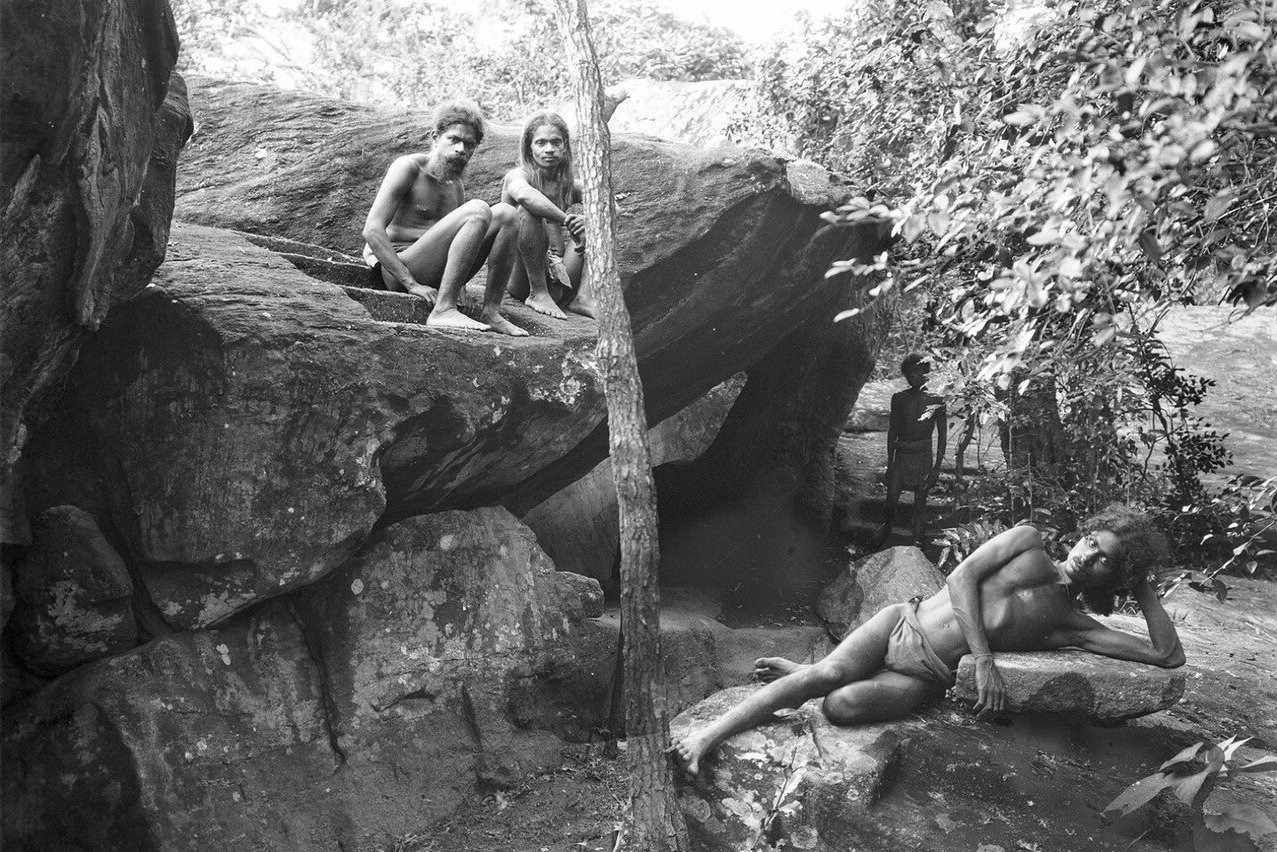
Wanniyala-aetto (“wanniyalätto” — “forest beings”; “me-ätto” — “this being”) live in forests east of central mountains, between Mahiyangana and Maha Oya. This is the most “classical” Veddah, strongly associated with the indigenous people of Sri Lanka.
The physical measurements on the living Veddahs and the skeletal remains available help to fix the definitions of Veddahs anthropometrically, and not only with certain accuracy, but according to certain criteria the physical measurements can be used to establish the racial type and also to compare it with other types that are known. On such a basis the anthropologists have established a racial type called “Veddid” or “Veddoid” (Hill 1941).
Hominids were probably present in Sri Lanka by 130 000 BP, possibly 300 000 BP (Deraniyagala 1992). The word “Veddah” is derived from the Sanskrit word “Vyadha” → “Viaddha” → “Veddha” → “Veddah”, and means “a hunter” or “one who live by the chase”. Another synonym for Veddah is “sabara”, which has two meanings — “Veddah” (hunter) and “an area having sabara trees”. Sabaragamuwa province may have acquired this name because it is considered to be the original habitat of the Veddahs (Wijesekera 1964). Wijesekera (1964) supposed that the aboriginal inhabitants of Sri Lanka who came into contact or conflict with the numerous newcomers from India absorbed the Indian settlers, acquired their status and language and, with some admixture of Dravidian blood or without it, became the Kandyan Sinhalese. They may have occupied the caves before the early Christian era. When Buddhism became established and the caves were occupied by monks, these people left them. These were re-occupied much later but that time they had lost their traditions and language (Kennedy 1974).
The first record of indigenous people in Sri Lanka appears in two quasi-historical scriptures — the “Dipavamsa” (4th century AD) and the “Mahavamsa” (6th century AD). These chronicles, written by Sinhalese, are religious justifications for Sinhalese appropriation of Sri Lanka. The writings describe a heroic conquest of the indigenous population, called the “Yakkahs” (demons / evil spirits), and narrate the Buddha’s blessing of the invaders. The “Mahavamsa” states that Buddha chose the Sinhalese as guardians of his teachings, and protected them against “the demons”. The “demons” withdrew into dense tropical forests (Stegeborn 1999).
Within the central Sri Lanka is situated “Mahayangana” (“Alutnuwara”) — the ancient assembling place of the “Yakkas” where, according to the “Mahawansa”, Lord Buddha appeared and struck terror into their hearts before propounding his doctrines. The “Mahavamsa” (Chapter 7) has recorded the story of the Yakkahs at Mahiyangana: “From Lanka filled with the Yakkahs, the Yakkahs must be driven forth… Mahiyangana was the customary meeting place of the Yakkahs, there was a great gathering of the Yakkahs dwelling in the Island” (Mahavamsa 1912). In about the time of Mahasena (277—304 A.D.) the Yakkahs appear to have been employed in building water tanks (Parker 1999). Most Wanniyala-aetto can’t read and write, they haven’t read the Sinhalese origin myth in the “Mahavamsa”, but the epics have been sung or told to them by literate Sinhalese. Parts of “Mahavamsa” subsequently been retold among the Wanniyala-aetto themselves until it has become an integrated part of their own history. The mythological history narrates that there were no humans in Sri Lanka, only evil spirits before the Sinhalese conqueror Vijaya arrived. Vijaya had a wife named “Kuveni”, a female spirit from Lanka, and they had a son and a daughter. Those children were the first Wanniyala-aetto. The siblings grew up and reproduced and the present Wanniyala-aetto are, according to the “Mahavamsa”, the result of that relationship. The Wanniyala-aetto who do not embrace the “Mahavamsa” story believe their ancestors have lived on Sri Lanka since time began, and do not trace their descent from any specific progenitor (Stegeborn 1993).
The earliest account (400 A.D.) about the Yakkas written by a foreigner, probably Palladius, is in “De Moribus Brachmanorum”. It mentions how a Theban traveler, who arrived to Ceylon in an Indian trading vessel from Axum, whilst travelling inland suddenly came upon the Besadae. He says that “these people are by far the smallest and weakest, they live in rock caves and know how to climb over the intricately massed rocks and thus gather pepper from the bushes” (Spittel 1957).
The Chinese traveler Yueng Chaing (700 A.D.) speaks of the Yakkahs as having retired to the South-East part of the island. The Arabic traveler Al-Beruni (1100 A.D.) describes the silent trade with savage “Ginn”. During the time of Parakramabahu (1163 A.D.) the “Kiratas” are mentioned thus: “There he sent his train of hunters, robbers and the like who were skilled in wandering by night in the wilderness of forest and mountain” (Cūlavamsa 1929). Who were the Yakkahs and what was their affinity to the Veddahs? The hunters referred to were probably Veddahs who were in the King’s retinue. “Kirata”, meaning “hunter”, is also used in Sanskrit to describe savage mountain tribe.
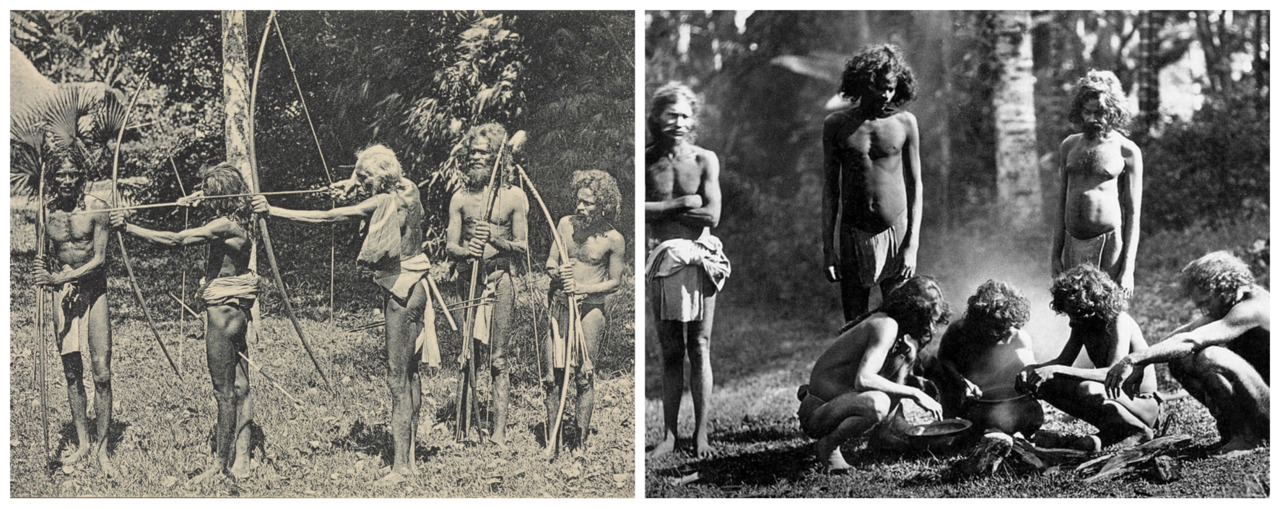
In 1675 Rijklof Van Goens, the Dutch Governor of Ceylon, gave a full description of the Veddas thus
“…A large number of Veddas or Beddas of Wellassa have been brought under. They should be carefully treated, neither too harshly nor too kindly. They should be made to work… fairly savage, they are brave fellows in the hunt and expert bowmen” (Spittel 1957).
Robert Knox (Knox 1681) mentioned that
“of these Natives there be two sorts wild and tame… For as in these woods there are wild beasts so wild men also. The land of Bintan is all covered with mighty woods filled with abundance of deer. In this Land are many of these wild men; they call themselves Vaddahs, dwelling near no other inhabitants. They speak the Chingulayes language. They kill deer, and dry the flesh over the fire, and the people of the country come and buy it of them. They never till any ground for corn, their food being only flesh. They are very expert with their bows. They have a little axe, which they stick by their sides, to cut honey out of hollow trees… They have no towns nor houses, only live by the waters under a tree, with some bought cut and laid about them, to give notice when any wild beasts come near, which they may hear by their rustling and trampling upon them”.
There is an information in Seligmanns’ book that Sinhalese of Vedirata told them that Veddah chiefs pay and offering to royal household in Kandy of honey, wax, and king might also invite their presence on special occasions. Each “Wanniya” bring with him a ceremonial fanlike ornament (which was still used by the Sinhalese chiefs) called “awupata” (literally “fan”), with an ornament made of wood or ivory on the top called “koraṇḍuwa” or “kota” (Seligmann 1911). Before the introducing of money, the barter was common. Trading places called “wadia” near the caves, but out of sight of them, under a tree or rock, were used for bartering.
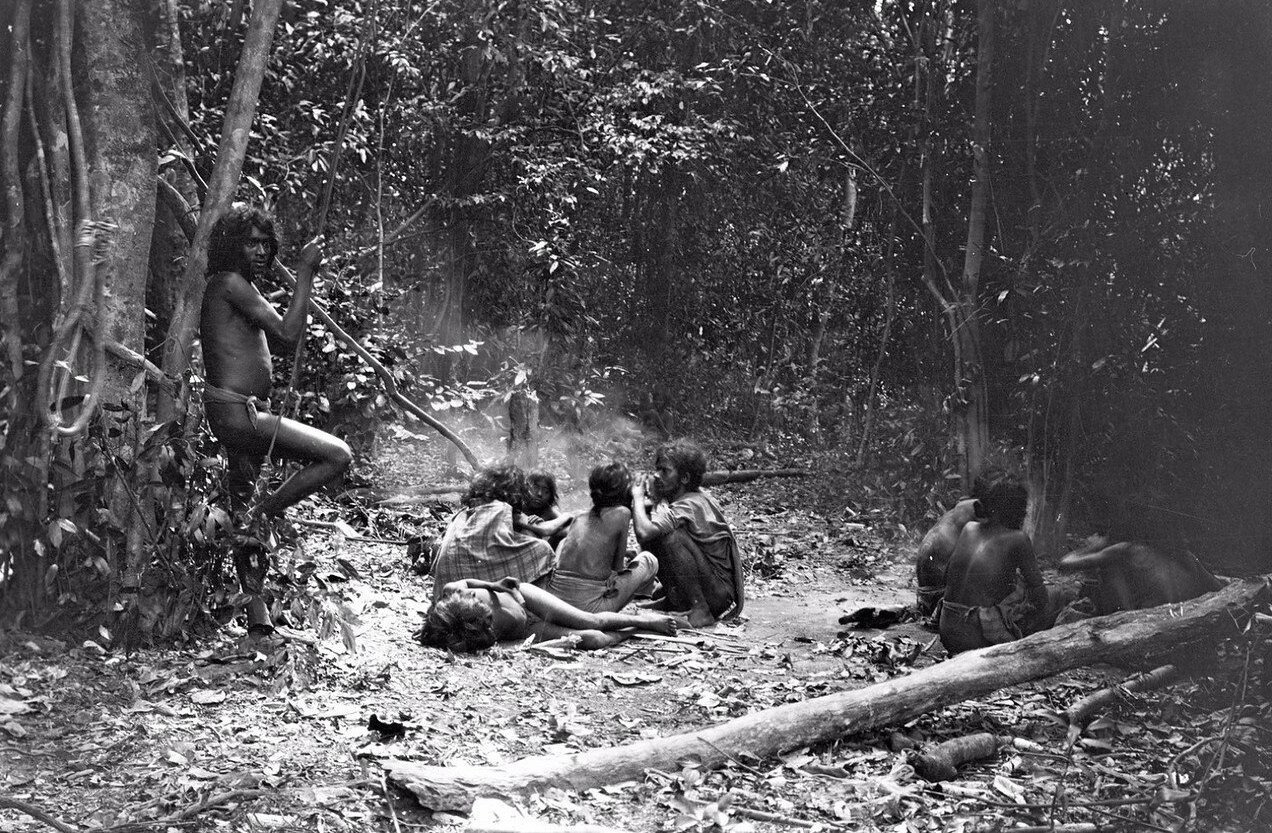
There are four traditional occupations of the “Wanniyala-aetto”: hunting and gathering, slash-and-burn cultivation and livestock herding, all combined with temporary employment as unskilled labors (digging wells or ditches, carrying soil, breaking stone or road construction).
Every Veddah man carried a bow and arrows (“tudaāi” — a number of arrows carried). For fletching used the feathers of the forest eagle owl (Huhua nipalensis), hawk-eagle (Spiraetus nipalensis kelaartii) and crested honey buzzard (Pernis apivorus ruficollis) (Stegeborn 1993), but also the feathers of peacocks, herons and hawks were used (Bailey 1863). The bow and arrows made up the characteristic weapon of the Veddahs. The bow was of the simple type — the double bend bow or the cross bow was not known to the Veddahs. The bows were made of peeled and shaved saplings of the “kobbe” tree (Allophylus cobbe) and bow-strings were made from the inner cortex of the “aralui” bark (Terminalia chebula). Arrow shafts must be straight and light so welan wood perfectly suited this purpose. Today the bow and arrows are almost only used for instructing and training young boys.
The Veddahs have learnt the use of the spring noose, dead fall and trap gun (Spittel 1957). Fish were caught and eaten when other food is scarce. The commonest method of catching the fish was to bale the water. A section of the stream was banked and the fish were stupefied by muddying or poisoning the water. The poison-bearing material was crushed and thrown into the pool or banked waterways. The water was stirred and as it got stained the fish become restless and stupefied. The fish leaped on the bank or fleet on the surface with belly upwards. Then it was easily collected (Spittel 1957). The fish could have also been dried over a trestle.

According to Knox, those Veddah who need a new arrow, should bring a deer flesh or honey to the blacksmith, and also a leaf “cut in the form they will have their arrows made”. Knox described the traditional method of preserving flesh: by putting flesh with honey in the hollow of the tree and stopping the hollow by the clay. Very interesting is the description of customs of giving hunting dogs with young girls while marriages, and traditions of leaving homes by Sinhalese to live with Veddah (Knox 1681). The steel heads of the axes were obtained from the local blacksmiths by bartering skins, honey and meat. So are the other steel implements such as arrow-heads, areca-nut cutters and strike-a-light obtained. No other cutting implement or knife was used.
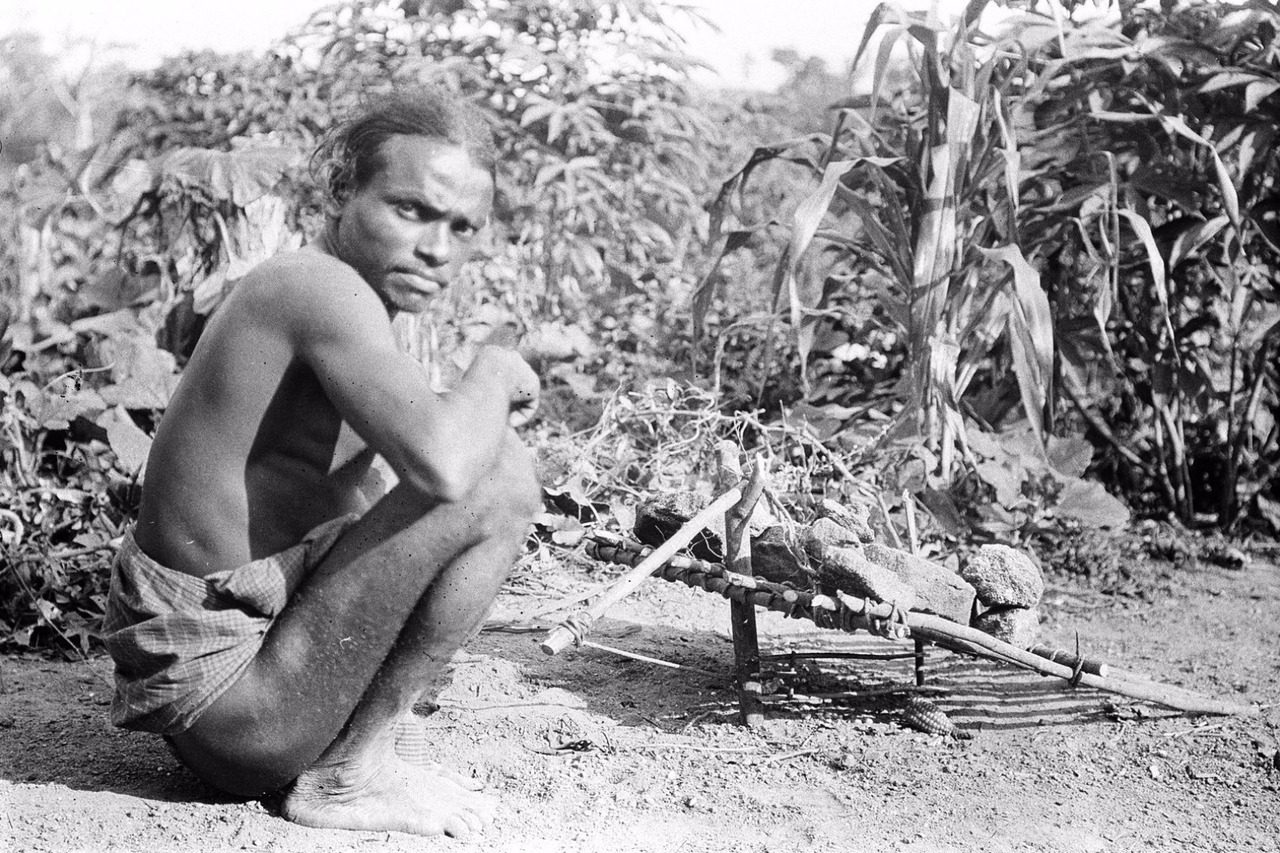
For trapping they employed poles, sticks, twigs and strings made from the bark of the “riti” tree (Antiaris innoxia). In 20th century the Wanniyala-aetto changed their hunting tools to muzzle-loaders, shutguns and knives, but still used traditional axes.
The summer dry season is the principal collecting time. Both women and men gathered. After a rain, mushrooms spread in the old chenas. Medicinal herbs are also collected by the family of the medicine-man. Only men hunted and trapped large animals; women snared small animals and birds. The spotted deer, the Asian sambhur deer (Cervus unicolor) and wild boar were favorite game animals. Monkeys, langurs, mouse deer, pangolins, mangoose, hares, monitor lizards were also taken (Stegeborn 1999). Wanniyala-aetto were not found of eating birds, neither wild nor domesticated. Notes (1901) mentioned that Wanniyala-aetto didn’t eat buffalo and porcupine, but Wiweca Stegeborn (1993) named porcupine in the list of the game they hunted. No one hunted elephants. Monkey skin was also used to make a betel pouch.
Once an animal was killed, there were many chores to accomplish. A large animal was chopped up and smoked to lighten the burden of carrying it back to the hamlet. Firewood needed to be collected, smoking tables needed to be constructed and the meat was sliced into thin strips. With a large animal such as sambhur, the butchering and smoking might have taken twelve to eighteen hours.
Sometimes close collaboration is required by several men to butcher and carry the game back home. Large parties formed if the resources were plentiful as for example when the trees were heavy with “mora” (Niphelium longana) and tamarind berries (Dialium ovideum).
In the dry season, tree blossom and bees are active. The men searched for honey and beeswax, principal items of trade. The favorite bees were the “Apis indica” and the “Apis dorsata”. Wanniyala-aetto had secret places, passed from generation to generation, where they went to collect honey and beeswax. They also collected barks (which used to make cloth bags), sap and resins, while women gathered medicinal herbs, leaves, berries and nuts, most of which were sold to Sinhalese pedlars. Honey was also a useful medium for barter with the Moor traders and the neighboring villagers. The Sinhalese use it for medical purposes (Wijesekera 1964). The Veddahs eat the larvae and wax with the honey.
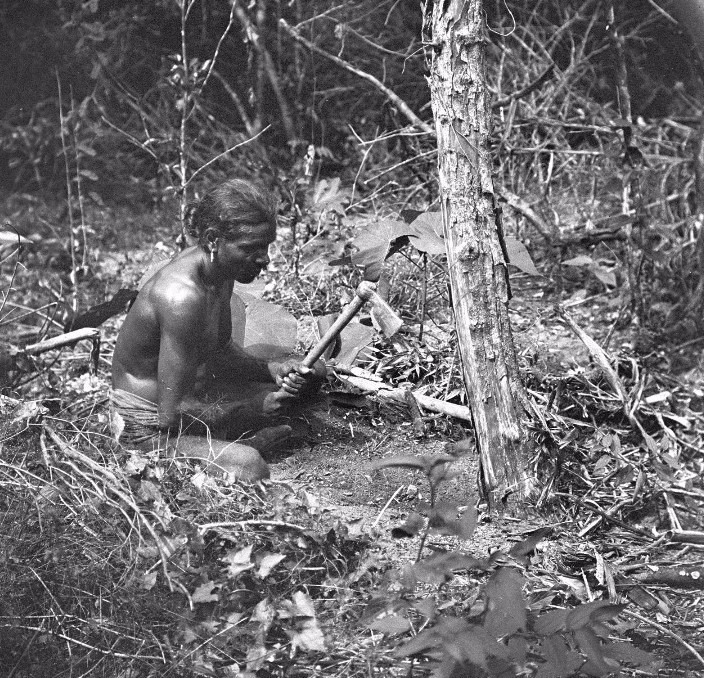
No one is denied access to the natural resources on which all of them depend. No individual owns the forest. The families have equal rights to acquire these resources but each extended family knows its traditional hunting and “chena” circles and those are respected by others. Hunting grounds were strongly marked for every “warige” (clan), and the intruder would be killed and his liver taken, then the piece dried in the sun in a secret place was keeping in betel pouch. No other part of the dead man had been used and such a custom gave rise neither to warfare not to vendettas (Tennent 1860). The Wanniyala-aetto do not have the economic base to sustain a military effort for a protracted period. They are not accustomed to being organized that can be mobilize or draft warriors, direct them and give them reasons to fight, so a war can’t be conducted. There is not much to gain by plundering other Wanniyala-aetto people. There are no standard items of exchange that serve as capital or as valuables, and the material wealth of these hunters and gatherers is inconsiderable.
Males started to learn the skills of tracking and hunting around the age of ten to eleven years. A boy was given his first bow as soon as he has been able to hold one (around three years old). This type of bow was basically built on the same principle as the slingshot; it was strung with two cords, connected at the centre by a one centimeter wide woven fiber mat. A small stone was placed in the mat and firmly gripped between the thumb and the fingers. When they were eight to nine years old they collected honey together. At the age of eleven, twelve or thirteen years, a boy started to accompany his father on one-day hunting trips.
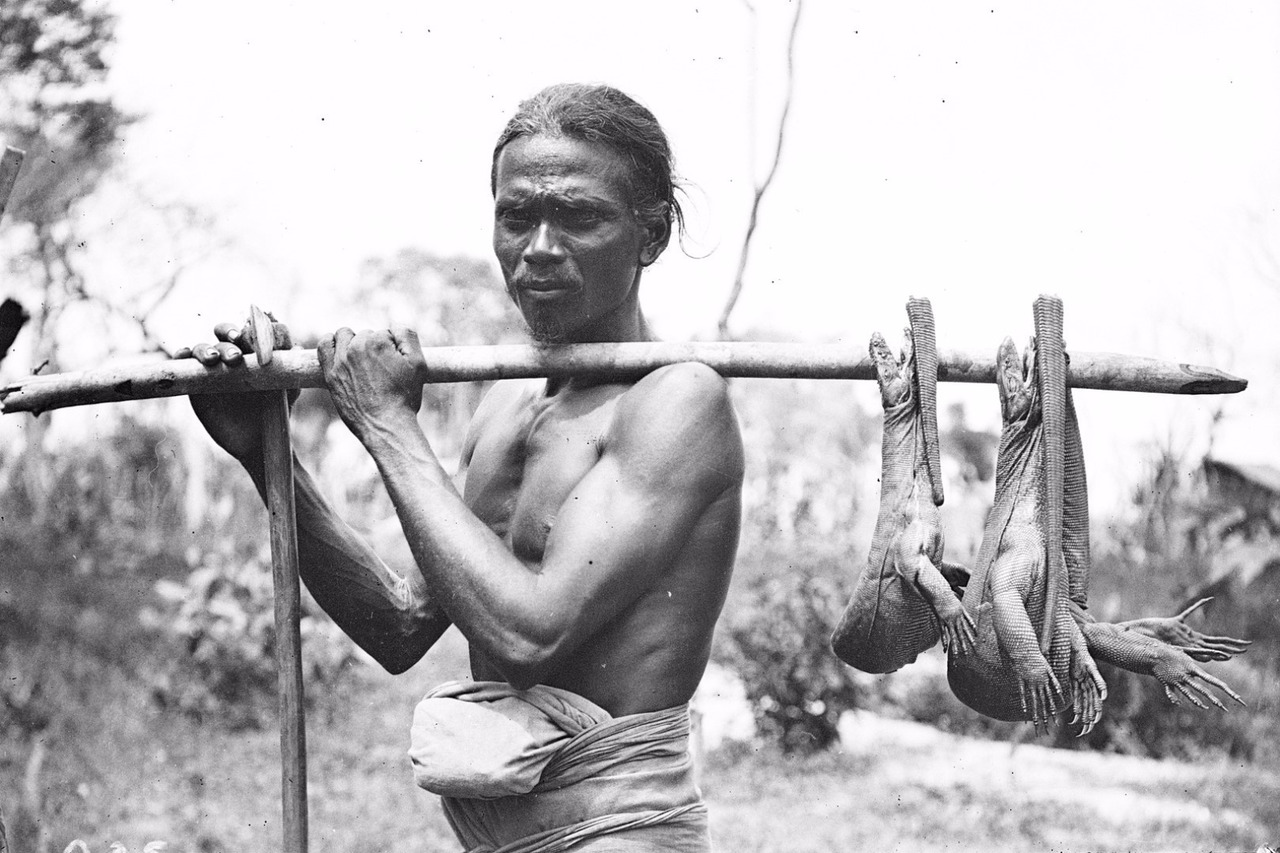
There are no full-time specialists among the Wanniyala-aetto. The shaman, for example, only exercise his craft upon request — he passes his days like everyone else. His sons may or may not become a shaman — no one insists, if the sons are not interested in that. Seligmanns stated (1911) that sometimes at Village Veddahs (i.e. in Horaborawewa) the shaman could be the local Sinhalese headman, who stated the same “yaku” (spirits) were invoked by Veddahs and Sinhalese alike. In the village of Lindegala (neighborhood of Kallodi) was a “vederale” (medicine man), who was tall and has represented typical Sinhalese features, also he was employed by the Sinhalese for miles round. Wanniyala-aetto society was egalitarian. There was no common authority ruling over all; nobody from one compound could have exercised power in another. All labor in this society was valued equally. Three activities involve special skills practiced only by men: shamanism, healing and drumming.
There are no headmen or chiefs — leadership is based on recognized ability in different activities. Fulltime specialists and differentiated economic, political and religious institutions are alien to the Wanniyala-aetto. They do have shamans and people who know about herbal medicines, but other than the family itself is the group that fulfill all roles. The only consistent supremacy of any kind is that of a person of higher age and wisdom who might lead a ceremony, a person with a special skill may be asked to give advice or occasionally to lead, a hunter with sharper eyesight may walk some steps ahead of the others when searching for game.
Justice as employed by the Wanniyala-aetto is based on common understanding. Relatives and friends of the accuser and the accused discuss and negotiate with each other until an acceptable agreement or a compromise is made. Direct confrontation between the parties is not the rule. After the consensus the two main protagonists meet directly to clarify and to confirm what they have agreed to, mediated by their delegated relatives and friends. This is usually accomplished in a polite and cordial manner, which prescribes a symbolic contribution of betel by the accuser to the family of the defendant, who in turn is invited to share a meal with them. Both parties find it equally important to maintain good relations and peace between the hamlets (Stegeborn 1993).
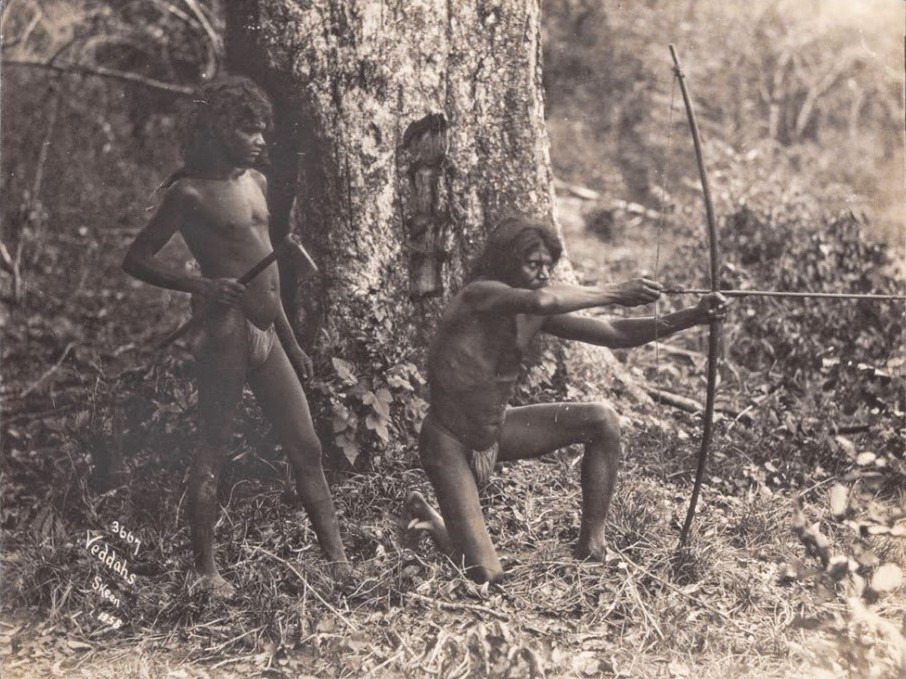
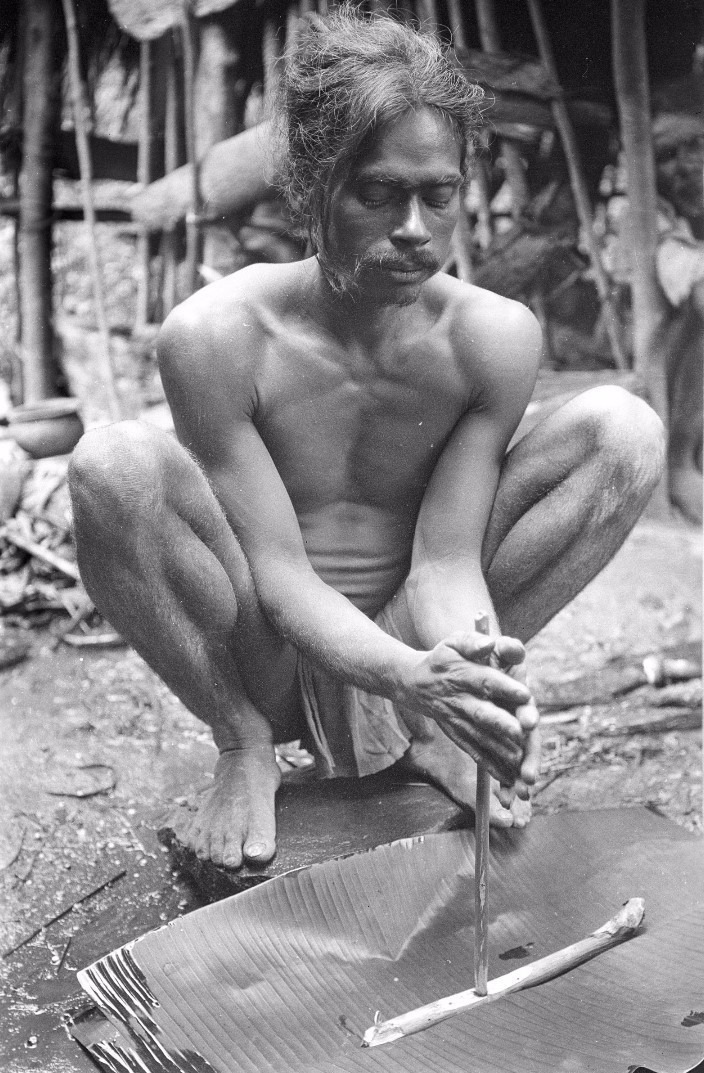
Among the Village Veddahs the women wore ivory studs in bored ears. Fire was obtained from two pieces of wood by drilling. The method of making fire by stone and a piece of metal, which is showing for tourists in Dambana as a traditional and ancient, was a traditional for Sinhalese (Rutimeyer 1903; Sarasin 1893). The tradition of chewing of areca-nuts or bark of trees mixed with burned land-shells (“wantako”) was very common.
The soil is poor and unproductive. But the Wanniyala-aetto plant many different grains, vegetables and tubers. Most of the Wanniyala-aetto clear a piece of land close to the house to do swidden cultivation of maize and “kurakkan” millet (Eleusine coracana). This type of cultivation is practiced by both Sinhalese and Tamil small scale farmers and is called “chena”. An enormous fence surrounding the chena must resist the elephants, be taller than the sambhur’s leap and tight enough to keep out the hares. Staples include maize, finger millet (Eleusine coracana) and dryland rice. They obtain wetland rice from Sinhalese shops. Maize is sown just before the monsoon in mid-September, followed by kurakkan in October, and it is time for the boys to make use of the double-stringed bow — they guard the chena from birds, then sambhur who is looking for a taller plants, and wild boars seeking roots. The chena can’t be cultivated for more than two to three years — then it must lie fallow for ten to twelve consecutive years (Spittel 1950).
The harvest time of the kurakkan millet is in February, which is done by the wife and the children. The main danger in this period is elephant who can eat 250—300 kg of vegetation per day. In March or April the corn cobs are ready and all the family members cooperate before the monkeys steal the crop. The chena must be guarded night and day. The Wanniyala-aetto build watch huts on poles in the middle of the field and on the trees at the edge of it. The husband and sons bear this responsibility. If animals come, the watcher shouts and makes noises, hitting buckets with sticks and stones. If elephants threaten, the guards shout for assistance, make torches from bundles of tall grass and chase the elephants away from their homes (Stegeborn 1993).
Some Wanniyala-aetto also cultivate a small garden close to home, where they grow manioc, beans, chiles, curry leaves (Murraya koenigii), pumpkins and plantains. They may also try to grow some betel vines (Piper betel), which is highly valued among them, but it is cheap to buy, so they generally obtain it at the local tea-shop (ibid.). A very old habit adopted from the Sinhalese long ago is betel chewing, together with the accompanying ingredients — areca-nut and lime. Betel is chewed together with the bitter tasting areca-nut from the betel palm (Areca catechu). Before putting the wad in the mouth, a “pinch” of lime is smeared on the leaf to give it the “right” taste. To give a mildly spicy flavor they sometimes add pieces of cinnamon bark and cardamom seeds (ibid.). The areca doesn’t grow wild in the Eastern Province (Seligmann 1911) or in the bordering Uva Province where the Wanniyala-aetto live. They buy areca-nuts, betel leaves, chewing tobacco, lime, coconuts, spices and edible fruits such as jack-fruit (Artocarpus integrifolia) at Sinhalese owned tea-shops. But it was difficult to obtain them in the forests, so they have modified their own substitutes which can be found in the forests. Such analogs can be made from the bark of the “demate” (Gmelina asiatica) and “davata” (Carallia brachiata, corkwood tree) trees which substitute for the betel leaf and areca nut respectively (Seligmann 1911). Then they collect large, white land snails (Cyclophorus volvulus), burn them in fires, pulverize the shells into powder, add water to make a paste and use this in place of lime (Spittel 1950).
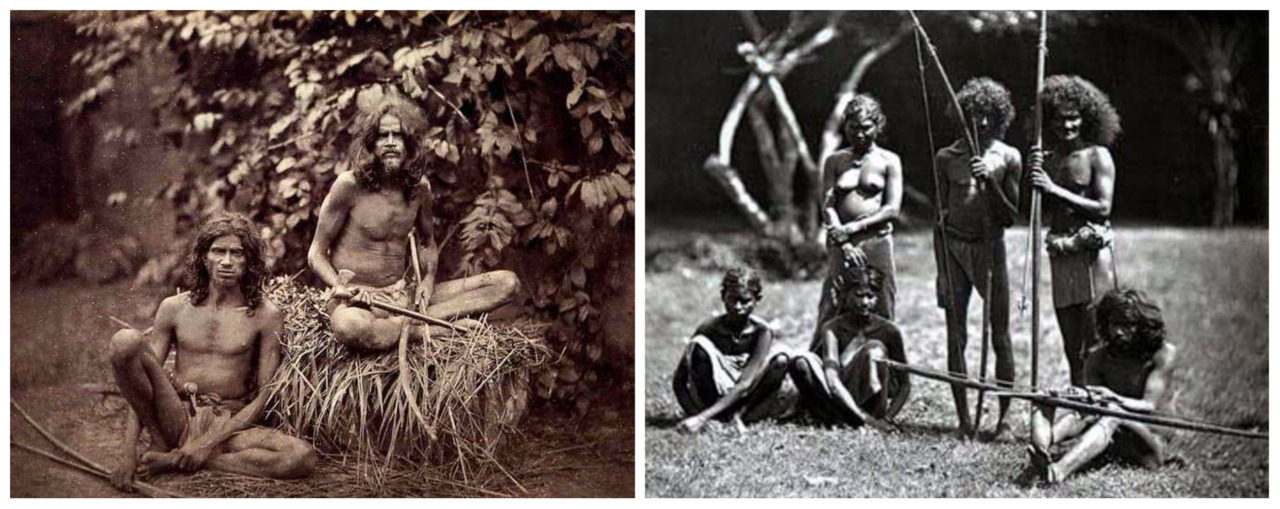
Important items used for trade are honey, meat, medicinal herbs, wild berries and cultivated grains. With the money they can buy clay vessels, cloth, salt, gunpowder and betel (Stegeborn 1993). Livestock herding has been adopted by a Wanniyala-aetto from their neighboring Sinhalese agriculturalists. On the first stage, Wanniyala-aetto came to watch the herds (the cattle graze around the house and sometimes the man’s wife or children bring them to other places where there is a fresh feed). In addition to the daily pay, they may receive a calf born that year. If they watch several herds, they obtain more livestock. The Wanniyala-aetto milk the cows, boil the milk and drink it or make yoghurt. Also they use cows to plow their rice-paddies. Some families have had four to five chickens freely walking inside and outside their houses, they were kept only for the eggs.
The Wanniyala-aetto do not eat their domestic animals such as their hunting dogs, chicken or cows. They are considered as pets and part of the compound like the children. The Wanniyala-aetto do not practice endocannibalism and do not eat their dead pets (Stegeborn 1993).
Nowadays the hunting and gathering traditions of the Wanniyala-aetto are almost lost. Some individuals sometimes go to collect honey and medicinal herbs. The native diet has changed considerably. Canned fish and meat replace fresh produce; sugar replaces honey; fewer vegetables are eaten. That contributes to new diseases: obesity, high blood pressure, heart problems, and alcoholism.
Nandadeva Wijesekera (1964) informed that “personal cleanliness of the Veddas leaves much to be desired, for sanitation and personal hygiene receive no attention. They wash their faces and mouths in the morning from a stream or water-hole nearby, as a matter of casual routine but thereafter for the rest of the day, although water may be available, they show no inclination to bathe in streams due to fear of being drowned”.
Also, Wijesekera supposes that the main reason is that they do not see the need to bathe nor can they think of any special benefit there from. He declares that very few “of the Veddas can swim even in streams and they do not dare to cross them unless forced to do so”, but he points out that the Veddahs love the rain, feel quite happy to get wet and thereafter sit by the fire (Wijesekera 1964). He mentions that the Veddahs seldom cut their hair, so their hair grow together into a massive lump. According to him, the act of beautifying the body, male or female, has never appealed to the Veddahs. Clothing was used only to cover their nudity. The hair is allowed to grow anyhow, the beard and moustache are not trimmed. But at the time of writing of that book (ibid.) the new habit of wearing by women necklaces of colored glass, beads, shell or bangles of ivory or brass; the practice of wearing ornaments (typical to Sinhalese and Tamils) became universal both among women and men. Due to Wijesekera, in the past flowers did not enter the scheme of adornment either of the person or hair, but “during recent times flowers and twigs have been used” (ibid.). We don’t have any concrete information about the group of the Veddahs which Wijesekera described, but the details given helped us to determine them as “Wanniyala-aetto”.
No mats were used by the Veddahs — they didn’t weave. Instead the skins of deer or sambur were used for sitting or sleeping and every family owned a number of them. At night a fire kept burning in front of the hut. The skins were also used to make bags or cushions. Also the “riti” bark was used for clothing and making bags. The custom of painting or tattooing their bodies or limbs was unknown to them (Brow 1978).
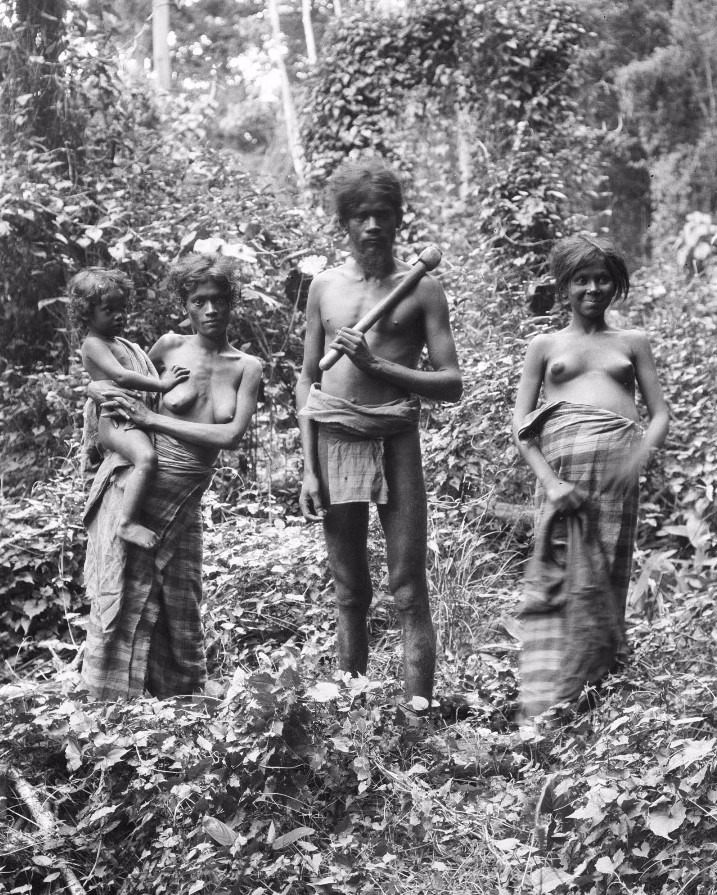
The average Wanniyala-aetto family size is six persons. Generally, residence is patrilocal. Descent is traced bilaterally. Marriage is preferred between patrilateral cousins, although anyone but the father’s brother’s child can be a potential spouse. A Wanniyala-aetto hamlet may involve three to nine families clustered together, each family in its own house. An average family includes a husband, wife and approximately three children.
Each group is named for local topography. Those dwelling near “mora” berries (Nephelium longana) are the “Morana Warige”. The people of the grasslands (“talawa”) are the “Tala Warige”.
Men were trained to use the bow, track animals, listen and interpret sounds of the nature, engage physical and mental activity and skills related to hunting. Adult women were the primary caretakers of the children. A child might be nursed until the age of four to five years — this prolonged lactation served as a method of birth control (Stegeborn 1993).
There was always someone at the house who took care of the youngest children, either an older sibling or someone from the extended family.
Stegeborn (1993) described in details the relationships with a dog. The hunting dog was a life-long partner, it was playmate for the children when it was a puppy and the disciplined companion of the hunter when it had become an adult. A well-trained dog knew when to bark and when to be quiet. The dog had to warn the house if elephants approach, but it had not been allowed to bark. It ran inside the house, sniffed its owner and danced around until everybody was alert. Stegeborn (ibid.) supposed that barking would have attracted the elephants to the hamlet because they seem to connect the dog with cultivation, and recognize that the barking sound means food, and perhaps salt from burned hearth wood. The domestic dog spent its life like any other member of the Wanniyala-aetto family, “the only difference is that he sleeps outside at night” (ibid.).
Veddas of Henebedda village (Nilgala district) belonged to “Namadewa” warige at the time of Seligmanns’ research (1911) lived in bark-covered huts, gather honey and hunt, several of them possess guns, and some of them rear cattle for the Sinhalese villagers. But Bailey (1863) first induced some Veddahs in the Nilgala district to make chenas (cultivated rain-fed lands) about the middle of the 19th century, before which all the Veddahs in this district were probably living their natural hunting and gathering life. While Veddahs of Danigala village of the same district were named as the classical “wild Veddahs”, at the time of Seligmanns’ research (1911) their own customs have been almost entirely forgotten. They have had chena and banana plantation and did a good trade in cattle both by herding for the Sinhalese (in case of herding received every fifth calf that born).
A number of “Morane” men stated that their ancestors came from Moranegala in the Eastern Province, but no Unapane man ever suggested that his clan had originally come from the place of that name near Kallodi. “Moranegala” is a hill name, and probably the hill has been named from the “mora” trees (Nephelium longana) which it may be assumed grew there, so that “Moranegala” means “the hill of the mora trees”, and it might be argued that Morane warige derived it’s name from the “mora” tree. In songs, collected at Sitala Wanniya, both men and women of “Morane” warige are addressed as “mora flowers” (Deschamps 1892).
A number of the Veddahs were politically organized in the 16th century and that one of the most important of their chiefs, described in a contemporary manuscript as “Panikki”, was appointed to the high office of Bandara Mudiyanse. It is recorded that Panniki the Veddah caught elephants and took them to the king (Mesuruer 1886).
The Wanniyala-aetto can be classified as sedentary people, as they generally stay at one place for several years. Normally the group moves together and the new site is located quite near the old one.
Seligmans (1911) give the information about the mobility of Veddah. Their residental moves per year are 3 times, average distance is 11,2 km (with total distance of 36,3 km). Logistical mobility is zero days and primary biomass is 17,2 kg per square meter. Total area of mobility is 41 square kilometers.
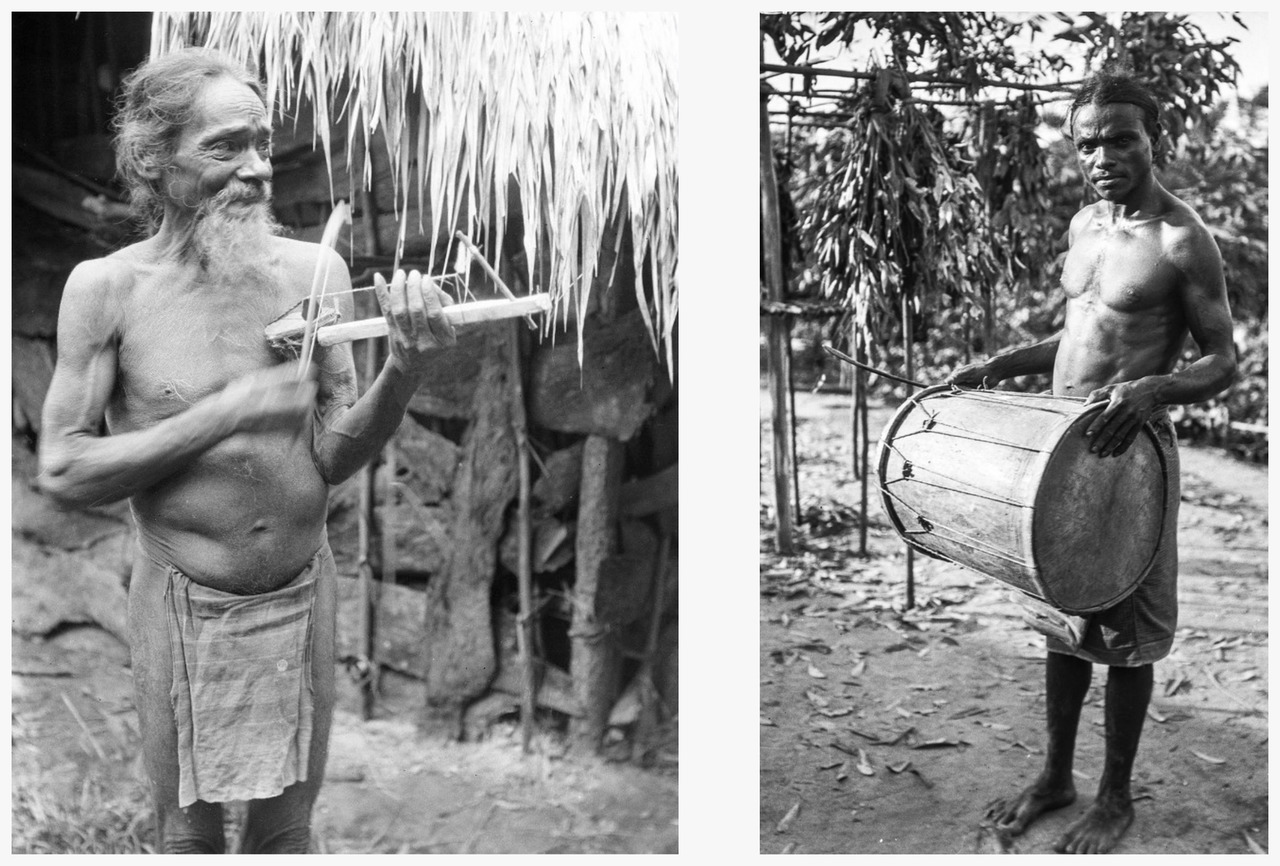
COASTAL VEDDAHS
Бесплатный фрагмент закончился.
Купите книгу, чтобы продолжить чтение.
